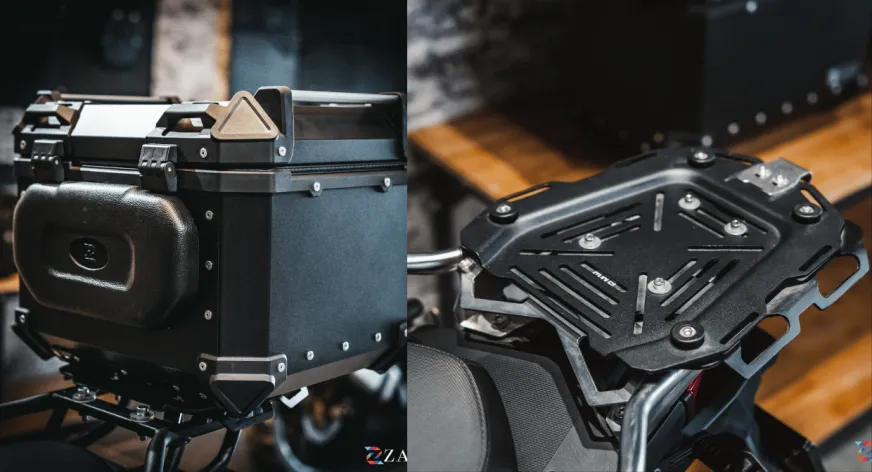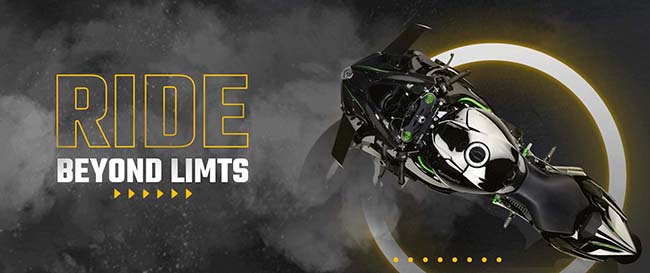
Your Rear Command Centre for Touring
Top Racks & Top Boxes: Your Rear Command Centre for Touring
Introduction: The Unsung Backbone of Motorcycle Touring
You can ride with just a helmet and gloves. But to ride far, ride serious, and ride self-supported through places like Spiti or Zanskar, your rear luggage setup becomes more than convenience—it becomes mission critical. That’s where a good top rack and top box come in. While often overlooked for sexier accessories like exhausts or crash bars, this duo is what separates casual cruisers from truly self-sufficient tourers.
At ZANA, we’ve fitted and tested rear racks on thousands of motorcycles—from the Classic 350 to the BMW GS series. And across terrains, one truth stands tall: if your tail setup fails, your trip fails. This blog is your detailed guide to understanding, choosing, and using the right top rack and top box—whether you're commuting, touring, or exploring unknown terrain.
What Is a Top Rack and Why Does It Matter?
A top rack is a load-bearing metal structure mounted behind the pillion seat. It’s designed to carry tail luggage—be it a strapped soft bag, a lockable hard top box, or even auxiliary fuel cans. But beyond that, a well-engineered top rack reinforces your bike’s tail structure, helps distribute weight more evenly, and acts as a secure mounting point that doesn’t stress your plastic bodywork.
It also becomes an anchor for bungee cords, tie-downs, or tail bags—and when done right, it does all this without compromising pillion comfort. Whether you’re a solo adventurer or riding two-up, the rack supports your touring ambitions quietly and reliably.
What Makes a Great Top Rack?
Not all racks are created equal. A reliable touring rack should mount directly to the subframe—not just the tail plastics. The welds should be continuous (TIG or MIG), ensuring strength under long-term vibration and flex. The platform needs to be wide enough for various luggage types, and the metal should be powder-coated or treated to prevent rust from rain, slush, or coastal salt.
A good rack also considers aesthetics. It should look integrated—not like an aftermarket add-on. Lastly, the holes and fittings must be compatible with common mounting plates—be it from ZANA, Viaterra, Givi, or Shad.
At ZANA, our racks go through real-life abuse on Manali-Leh routes and are then tested in the studio for shear force and vibration resistance. The end result? You get hardware that won’t crack, rattle, or shear—no matter how hard you ride.
Understanding Top Boxes: Types, Materials, Locks
Top boxes come in various forms, each serving a different kind of rider. The most common are plastic top boxes, which are lightweight, affordable, and ideal for city commutes. They typically mount via a plastic plate and offer basic lock protection. However, they’re often not waterproof or durable under high load or crash impact.
Aluminium top boxes, on the other hand, are designed for hardcore touring and ADV riding. These boxes are riveted, rubber-sealed, and built to withstand weather, dust, and vibration. They feature dual latch systems, foam-lined interiors, and superior locking mechanisms. Riders heading to Ladakh or Northeast India often swear by these.
There’s also a middle category—hybrid semi-rigid boxes—which offer flexibility, are expandable, and are perfect for riders who want some structure without the weight of full aluminium.
Do All Top Boxes Fit All Racks? Here’s the Truth.
This is where most riders go wrong. No, not all top boxes fit all racks. Many branded boxes require specific base plates, and if your rack isn’t pre-drilled or flat enough, you'll end up hacking together a risky fitment. Some tail racks are only meant for soft luggage, not 6 kg aluminium boxes. And using a plastic base on a weak rack can shear bolts and cause failures mid-ride.
ZANA designs its top racks to match its proprietary mounting plates but also offers universal hole patterns compatible with Givi, Shad, and other popular box brands. Our racks are reinforced with crossbars and laser-cut to avoid stress points, especially when loaded with 10–15 kg of luggage.
How Real Riders Use Their Top Rack & Box Combo
City Commuter:
Uses a lightweight top box to store a spare helmet, gloves, raincoat, and other daily essentials. This eliminates the need for a backpack and keeps gear secure during office hours or errands.
Weekend Tourer:
Combines a top rack with a strapped soft tail bag or hybrid top box. Ideal for quick access to clothes, rain liners, snacks, or a camera when riding light for 1–2 day getaways.
Long-Distance ADV Rider:
Installs a heavy-duty aluminium top box on a reinforced rack. Carries tools, documents, food supplies, chargers, and valuables in a lockable, waterproof container—critical for high-altitude or off-road terrain.
Moto-Vlogger / Photographer:
Packs delicate gear like cameras, drones, lenses, and hard drives into foam-padded boxes. The top box acts as a stable vault with easy roadside access for filming on the move.
Couple Touring (Pillion Use):
Uses the box for shared essentials—rain gear, spare clothes, medicines—while offering the pillion a backrest and grip support. The rack ensures stability without compromising seat space.
ZANA Top Racks: Designed for Indian Roads, Built to Tour
ZANA’s rear racks are designed for practical, real-world use on Indian motorcycles. They’re engineered to bolt directly onto factory points—no jugaad, no welding needed. Here are some highlights:
All racks are black powder-coated, rust-resistant, and field-tested from Kerala’s monsoons to Himachal’s altitude extremes.
ZANA Top Boxes: Built to Ride, Locked to Trust
ZANA doesn’t outsource its top boxes. It builds them. Right here. In India. For Indian roads.
Every ZANA top box is constructed from high-grade aluminium, not plastic, and built to take a beating—whether it’s a speed breaker in Surat or black ice in Tawang. The body is riveted and silicone-sealed, making it dustproof and rain-resistant. The dual-lock mechanism ensures your gear stays safe—on highways, hotel parking lots, and border checkposts.
These aren’t flimsy plastic carriers. They’re engineered utility boxes for serious riders.
Available Sizes:
22 to 55 litres many many options typically every 2litres and 2000 rupees there is an option
Key Features:
– Aircraft-grade aluminium build
– Matte black powder-coated finish
– Dual latch locks with padlock support
– Reinforced base for rack compatibility
– Internal rubber lining + foam kit ready
– Reflective rear decals for night visibility
– Optional backrest pad for pillions
Mounting:
All ZANA top boxes come with a universal mounting plate compatible with most ZANA and third-party racks (Royal Enfield, KTM, Hero, Bajaj, BMW, Triumph, etc.). Bolts, washers, and gaskets are included. No drilling. No rattling.
Real-World Tested:
From Himachal slush to Konkan coastlines, these top boxes have done the miles. Riders have stored laptops, drone gear, DSLR kits, wet clothes, boots, and tools inside—and come out dry, clean, and secure.
Packing Tips: What Goes Where?
Keep your packing balanced. The top box should carry lightweight but critical items like documents, electronics, snacks, and camera gear. Heavy tools or liquids should be in saddle bags or tank panniers to keep the centre of gravity low. Never overload the top box with fuel cans or toolkits—it strains the subframe and affects handling. Always use foam liners to protect fragile gear and double-check the lock system before riding out.
Final Thoughts: It's Not Just Storage—It’s Structure
Your top rack and top box are more than a way to carry stuff—they’re a structural foundation for your touring setup. Done wrong, they buzz, break, and bend. Done right, they carry your world safely across the toughest roads.
Choose gear that’s been tested on the road, not just on CAD software. Choose welds that hold up to Himachal potholes and Northeast rain. Choose a system that integrates with saddle stays, crash guards, and riding posture.
Choose ZANA.
Because when the road tests everything—your rack should be the last thing you worry about.











